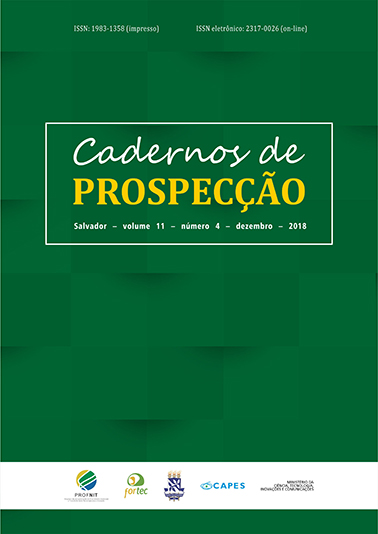Innovative Capacity on the Brazilian Patentary Optical of the Use of Nanotechnologies in the Textile Industry
DOI:
https://doi.org/10.9771/cp.v11i4.26860Keywords:
Textile, Nanotechnology, Patent documents, Technological Mapping, Innovation.Abstract
The textile industry has sought to innovate in its products and processes, such as the use of nanotechnology - technology of materials, processes and products whose dimensions are in the range of tenths to hundreds of nanometers - with the use of nano-fibers and fibers containing nano particles, and, finishing / coatings containing nano substances. Among these, we highlight the carbon nanotubes (CNT) that are used to increase fibers. In order to evaluate the innovative capacity of the technologies involved in this scenario, the data of the patent documents extracted from the INPI-BR database were used, where 335 patent documents were related, 32 of which were related to nanotechnology in the textile industry between 2009 and 2013, of these 19 refer to nano-fibers (13 of which refer specifically to CNT), and 13 refer to the treatment of nano-fibers. The time evolution has shown increasing between 2010 and 2012 and slight decline in 2013. It was found that the patent documents that had their family originated in the USPTO and UKIPO offices had more relevance in the patent deposits with focus on CNT, other nano-fibers and in the treatment of nano-fibers.
Downloads
References
ELECTION. Nanotechnology & Textiles. 2012. Disponível em: < http://5election.com/2009/11/14/nanotechnology-textiles/>. Acessado em: 02 jul. 2012.
BERINGER, J. Nanotechnology in Textile Finishing. 28 nov. – 12 dez. 2005. Disponível em: <http://www.nanomat.de/pdf/nanovision-beringer.pdf>. Acessado em: 02 jul. 2012.
BUZZANGA, J. Using Technology intelligence for R&D. 3 set. 2008. Disponível em: <http://www.industryweek.com/articles/using_technology_intelligence_for_rd_17162.aspx>. Acessado em: 02 jul. 2012.
CARLES, M.; HERMOSILLA, L. Nanomedicina: Médicos Microscópicos. Revista Científica Eletônica de Psicologia, ano IV, n. 06, fev. 2007. Disponível em: <http://faef.revista.inf.br/imagens_arquivos/arquivos_destaque/KB5P1NuxXXW7Kfw_2013-5-27-17-30-20.pdf>. Acessado em:
FREIRE, E.; AI, F. S. Avaliação do impacto da nanotecnologia na indústria têxtil. Projeto final de curso apresentado à Escola de Química da Universidade Federal do Rio de Janeiro. 2010.
GUIMARÃES, R. M. C.; BRAGA JR., E.; BANJA, M. E. Estudo teórico da nanotecnologia aplicada à cadeia têxtil. Monografia. Projeto de graduação submetida à comissão examinadora do curso de engenharia têxtil da faculdade SENAI-CETIQT, 2006.
HAUPT, R.; KLOYER, M.; LANGE, M. Patent indicators for the technology life cycle development. Research Policy, n. 36, p. 387–398, 2007.
INSTITUTO NACIONAL DE PROPRIEDADE INDUSTRIAL - INPI, 2018. Disponível em: <http://www.inpi.gov.br>. Acessado em: 11 jun. 2018.
MARTINEZ, M. E. M.; REIS, P. C. dos; SANTOS, D. A.; WINTER, E.. Avaliação do Emprego de Nanotecnologias no Setor Têxtil por Meio de Documentos de Patentes. In: Anais do IV Encontro Acadêmico de Propriedade Intelectual, Inovação e Desenvolvimento - ENAPID, 2012, Rio de Janeiro. ENAPID, 2012a.
_______. Avaliação do Perfil Petentário do emprego de Nanotecnologias no Setor Têxtil. In: Anais do II Congresso Brasileiro de Prospecção Tecnológia – ProspeCT&I, 2012, Salvador: ProspeCT&I, 2012b.
MENDES, C. D. S.; RODRIGUES, R. C.; LUNA, L. C. Nanotêxteis: análise dos pedidos de patente no Brasil para estudo da P&D e inovação. Jun. 2012. Disponível em: <http://www.inpi.gov.br/images/stories/Nanotexteis_Jun_2012.pdf>. Acessado em: 02 jul. 2012.
MIRANDA, J. M. S. A Nanotecnologia como Fator Estratégico de Inovação Competitiva no Setor Têxtil. Disponível em: <http://pt.scribd.com/doc/6563533/Palestra-NonoTecnologia-Textil>. Acessado em: 02 jul. 2012.
NANO WERK. Nanotechnology textiles. 16 dez. 2010. Disponível em: < http://www.nanowerk.com/spotlight/spotid=19451.php> Acessado em: 02 jul. 2012.
OLIVEIRA, A. P. Pele de tubarão - Shark Skin. 2009. Disponível em: < http://www.oarquivo.com.br/index.php?option=com_content&view=article&id=274:pele-de-tubarao-shark-skin&catid=71:ciencia-e-tecnologia&Itemid=62>. Acessado em: 02 jul. 2012.
PORTUGA TEXTIL. Indústria Têxtil da República Checa com Tradição Parte 1. 2004a. Disponível em: <https://www.portugaltextil.com/industria-textil-da-republica-checa-com-tradicao-%c2%96-parte-1/>. Acessado em: 11 jun. 2018.
_______. Indústria Têxtil da República Checa com Tradição Parte 2. 2004b. Disponível em: <https://www.portugaltextil.com/industria-textil-da-republica-checa-com-tradicao-%c2%96-parte-2/>. Acessado em: 11 jun. 2018.
SÁNCHEZ, J. C. Têxteis Inteligentes. Química Têxtil, n. 82, p. 58-77, mar. 2006. Disponível em: <http://www.ufjf.br/posmoda/files/2008/07/T%C3%AAxteis-inteligentes.pdf>. Acessado em:
SIEGFRIED, B. Nanotextiles: functions, nanoparticles and commercial applications. Semester thesis in the frame of the “Nanosafe-textiles” project TVS Textilverband Schweiz and Empa. 2007.
WIPO REFORMED IPC. 2018. Disponível em: <http://www.wipo.int/ipcpub/#lang=en&refresh=page>. Acessado em: 11 jun. 2018.
WORLD INTELLECTUAL PROPERTY ORGANIZATION – WIPO. 2018. Disponível em: < http://www.wipo.int>. Acessado em: 11 jun. 2018.
Downloads
Published
How to Cite
Issue
Section
License
Copyright (c) 2018 Cadernos de Prospecção

This work is licensed under a Creative Commons Attribution-NonCommercial 4.0 International License.
O autor declara que: - Todos os autores foram nomeados. - Está submetendo o manuscrito com o consentimento dos outros autores. - Caso o trabalho submetido tiver sido contratado por algum empregador, tem o consentimento do referido empregador. - Os autores estão cientes de que é condição de publicação que os manuscritos submetidos a esta revista não tenham sido publicados anteriormente e não sejam submetidos ou publicados simultaneamente em outro periódico sem prévia autorização do Conselho Editorial. - Os autores concordam que o seu artigo ou parte dele possa ser distribuído e/ou reproduzido por qualquer forma, incluindo traduções, desde que sejam citados de modo completo esta revista e os autores do manuscrito. - Revista Cadernos de Prospecção está licenciado com uma Licença Creative Commons Attribution 4.0. Esta licença permite que outros remixem, adaptem e criem a partir do seu trabalho para fins não comerciais, e embora os novos trabalhos tenham de lhe atribuir o devido crédito e não possam ser usados para fins comerciais, os usuários não têm de licenciar esses trabalhos derivados sob os mesmos termos.
Este obra está licenciado com uma Licença Creative Commons Atribuição 4.0 Internacional.





